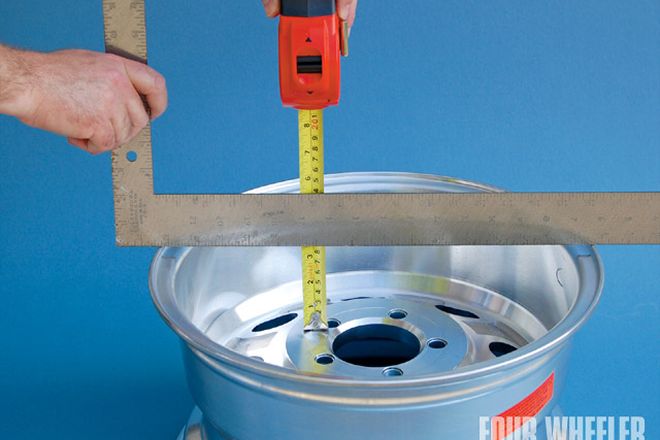
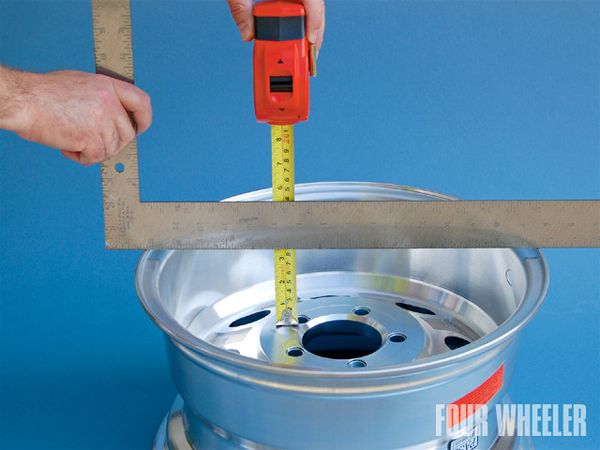
Wheels are probably one of the least understood and yet most important part of your 4x4's drive system. Most of the time, people choose their wheels simply by what design looks good to them. While this is an important aspect, wheels perform a critical function. Select the wrong one for your application and you could create a vehicle that's miserable to drive, or worse yet, cause an accident. From the basics of choosing the right size for your tires to the critical elements of load ratings and construction type, there are plenty of opportunities to get it wrong. That's why we'll spend the next few pages sharing tips with you that will help you find the wheels that are right for the function of your vehicle.
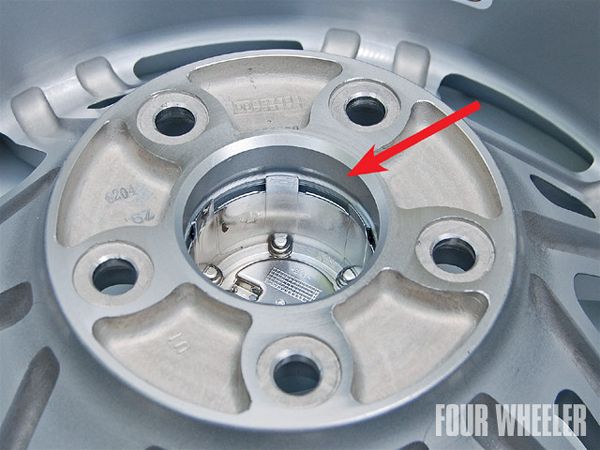 The wheels from Rugged Ridge and AEV are made specifically for Jeep vehicles. They are engineered to fit these vehicles exactly, and that includes a hub-centric design. That means that the center of the wheel (arrow) is machined to fit exactly around the flange on the vehicle's axles. This is the way the factory does it for a precise fit. Additionally, they have optimal offset and brake clearance for these Jeep applications.
The wheels from Rugged Ridge and AEV are made specifically for Jeep vehicles. They are engineered to fit these vehicles exactly, and that includes a hub-centric design. That means that the center of the wheel (arrow) is machined to fit exactly around the flange on the vehicle's axles. This is the way the factory does it for a precise fit. Additionally, they have optimal offset and brake clearance for these Jeep applications.
Material and Construction
For the most part, wheels are made from steel or aluminum. Steel was once favored for its low cost and high strength. For four-wheeling, it offers one huge advantage: When you smack a rock, the wheel bends instead of breaking. Of course, the wheel will need to be replaced or fixed eventually, but it keeps you going. If you live in a salty climate, steel wheels will need to be sandblasted and painted every few years. For the 4x4 market, there are several steel wheels available. Generally speaking, they are the least expensive option.
Aluminum was first used in wheels because of its light weight. The wheel and tire combination rotates mass, and it is unsprung weight (it's on the ground side of the suspension system). A reduction in unsprung weight results in better fuel economy, better acceleration, and better braking performance. The weight of the tire has a much greater affect on this because it's further from the axle centerline, but saving five pounds per wheel still makes a difference. In the early days, aluminum wheels were expensive and manufacturers hadn't figured out proper finishes, so the wheels became corroded and pitted over time.
Things are quite a bit different today, driven partially by the fact that nearly all original equipment wheels are made from aluminum. Aluminum wheels can be very affordable now, and there is quite a variety of finishes that offer long-lasting, low-maintenance appearance, and look good, too.
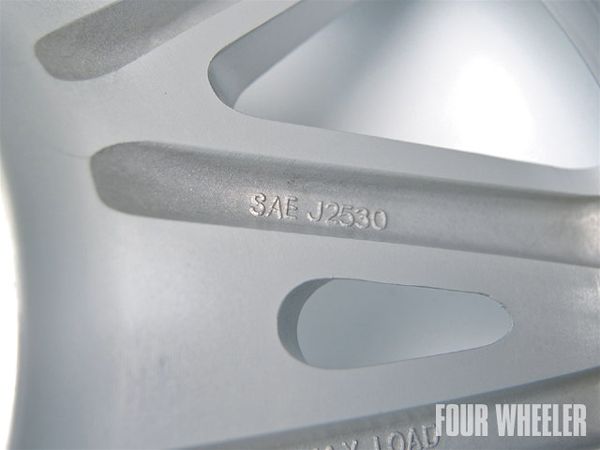 Is your wheel seeking approval? All of the wheels shown in this article meet the SAE J2530 standard, which is specific to aftermarket wheels. Tests for this standard include radial and lateral fatigue, as well as impact.
Is your wheel seeking approval? All of the wheels shown in this article meet the SAE J2530 standard, which is specific to aftermarket wheels. Tests for this standard include radial and lateral fatigue, as well as impact.
You may hear people talk about how much better forged aluminum wheels are compared to cast. While it is true that forged wheels are stronger and they weigh less, nearly all the wheels you'll find in the 4x4 market are cast. Forged is much, much more expensive, and cast aluminum wheels have improved significantly in strength and quality over the past 20 years. Forged wheels are mostly used in racing and in applications that require extremely high load ratings, such as tractor trailers.
Most of the aluminum wheels offered in the off-road market are made from A356 alloy, and they are made using a low-pressure casting. This process uses low pressure to draw molten aluminum into the casting form instead of relying on gravity. The result is a higher-density wheel with less porosity, which is good for consistent strength and minimized chances of structural wheel failure.
Finishes
While it's usually pretty easy for a person to decide whether they want a chrome look or high-gloss black, it is easy to overlook the function of the wheel finish. In addition to how the wheel looks when it's new, the finish dictates how much work you'll have to do to do keep it looking nice. While chrome and paint are your choices for steel wheels, here are the more common finishes for aluminum, with the pros and cons.
Chrome: One of the easiest finishes to maintain, chromed aluminum gives you the advantage of an aluminum wheel with a bright shine that is easy to clean and maintain. This finish is mirror-like, and it resists corrosion and pitting. Lower-quality chrome can crack and chip over years of exposure to rough elements.
Polished: This is another bright finish, but isn't quite mirror-like. It's often considered a more refined look. Drawbacks are that it requires regular cleaning and polishing to maintain a bright finish, but the advantage is that it can always be brought back to the original finish.
Powdercoat: This provides a range of color options with a highly durable finish. It is very easy to maintain and it resists scratches, corrosion, and pitting. Popular colors today are black, silver, and shades of gray. However, powdercoat can come in virtually any color, and in some cases it may be more affordable than paint.
Clearcoat: A finish that got a bad rap in the '80s (some OE wheels had their clearcoat crack and peel after a few years), a clearcoat is a protective coat over a color or the natural aluminum material. A high-quality clearcoat is easy to clean and resists corrosion and pitting. Paint with clearcoat is one of the most common finishes on modern aluminum wheels.
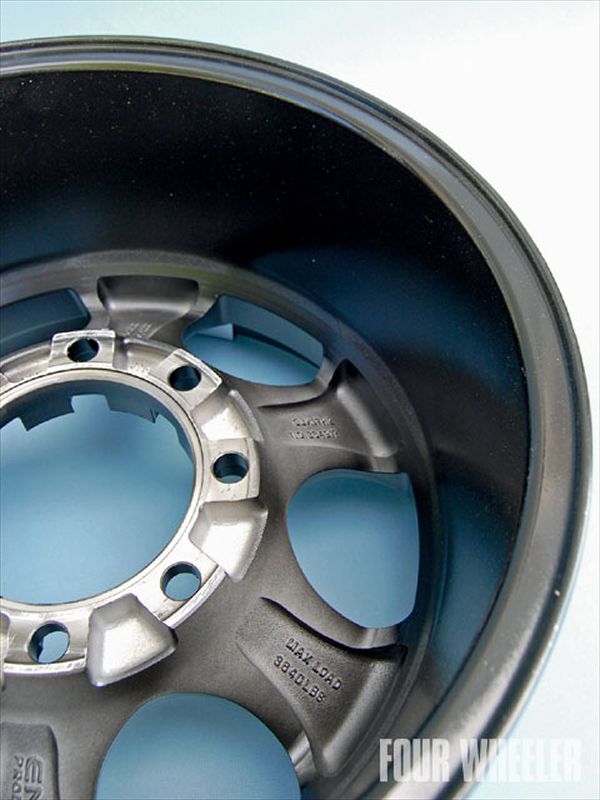 Clearance for brake calipers, and in some cases suspension components, must be considered when choosing a wheel. Some wheels, such as the Dick Cepek DC-1 wheel shown here, are designed specifically for late-model vehicles with large brake packages. This is one reason that you should not decrease the wheel diameter from stock. Even keeping the same wheel diameter can create an issue. Never grind the wheels, brake, or suspension components for added clearance. If the new wheels don't fit, don't use them.
Clearance for brake calipers, and in some cases suspension components, must be considered when choosing a wheel. Some wheels, such as the Dick Cepek DC-1 wheel shown here, are designed specifically for late-model vehicles with large brake packages. This is one reason that you should not decrease the wheel diameter from stock. Even keeping the same wheel diameter can create an issue. Never grind the wheels, brake, or suspension components for added clearance. If the new wheels don't fit, don't use them.
Make Sure It Fits
Ironically, this is one of the most overlooked factors in choosing a wheel, and it is one of the most important. We can't tell you how many 4x4s we see with the absolutely wrong wheel size or backspacing, and it's because the owner didn't know what questions to ask. A lot of local tire stores are very good at helping you choose the right wheel, but there are also quite a few who try to stock as few parts numbers as possible and make whatever they have fit your vehicle.
There are really only three things you need to know to nail wheel fitment. The first is the simplest: The diameter of the wheel needs to match your tire! If you have a 305/65R17, you'll need a 17-inch wheel.
The next is more difficult: The width of the wheel needs to be appropriate for the width of the tire. Every tire manufacturer gives a specific range of recommended wheel width for the specific make and size tires. Find the chart online and use it. Generally speaking, tire manufacturers recommend a wheel that is two to three inches narrower than the tire's section width. We usually prefer to stay on the narrow side (but still within the manufacturer's range) because the extra bulge of the tire sidewall on a narrow wheel helps protect the wheel lip against debris. But going too narrow compromises the tire's ability to provide road traction and can decrease how well the tire seats on the bead of the wheel. A wheel that is too wide for the wheel also compromises the tire's performance and the bead seal.
By far, the most difficult part of tire fitment is backspacing or offset, depending on which wheel company you're talking to. And these two ways of measuring the same thing are not the same.
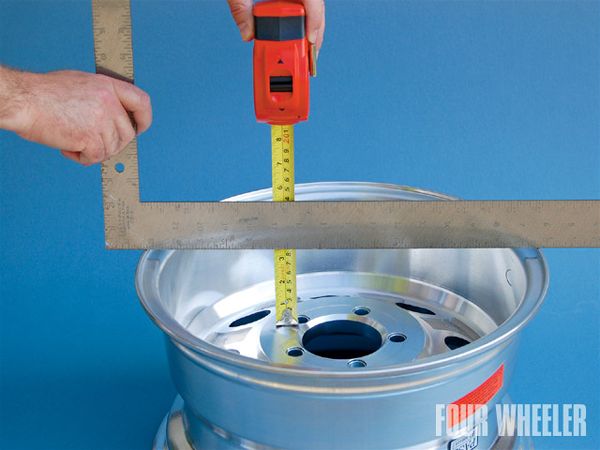 Whichever style of wheel you choose, you have to make sure they will fit your 4x4 properly. The right way to measure backspacing is to lay a straight edge across the rear edge of the wheel and measure to the mounting flange. Start with the wheels and tires you have now, and determine what backspacing you'll need in order to fit the wider tires that you're likely installing with your new wheels. See the main article for an example.
Whichever style of wheel you choose, you have to make sure they will fit your 4x4 properly. The right way to measure backspacing is to lay a straight edge across the rear edge of the wheel and measure to the mounting flange. Start with the wheels and tires you have now, and determine what backspacing you'll need in order to fit the wider tires that you're likely installing with your new wheels. See the main article for an example.
Offset is the measurement from the mounting surface of the wheel to the centerline of the wheel. The number can be positive or negative, with a positive offset meaning that the mounting face of the wheel is outboard of the centerline. A lot of wheelers don't like talking about offset because it's not something you can measure yourself. Offset is a great measurement to do from engineering drawings, but it's simply not possible for you to find the centerline of the wheel and measure how far off the actual wheel-mounting surface is.
Backspacing is the measurement from the wheel mounting surface to the rear lip of the wheel. A lot of wheel manufacturers don't like using backspacing for two reasons. First, for overall fitment, it doesn't take into account the wheel width. This can lead to some really bad steering and handling characteristics. The second reason is that it measures from the outside lip of the wheel, while wheel width is measured from one bead surface to the other. So a wheel with a thick wheel lip has greater backspacing without telling you where the wheel-mounting surface is relative to the wheel center line. This also means that two wheels can have different backspacing because of a difference in wheel lip thickness, but actually have the same offset. The big advantage of talking backspacing is that you can measure it yourself to compare the wheels you have now to what you are shopping for.
If you're putting larger wheels and tires on your 4x4, you'll need to have a basic understanding of these measurements in order to get the right fit. For handing and steering purposes, you want to keep the wheel offset close to stock. But for larger tires, you usually need to move the wheel outboard, decreasing the offset, to keep the tires from hitting the frame, inner fender panel, and suspension components. This is simplest when you're building a common 4x4, such as a Wrangler, where lots of companies know exactly what wheel offset is required for specific tire sizes.
For other 4x4s, by working with a backspacing measurement, you can determine what will be optimum by measuring your existing wheel and tire combo. You'll need to have overall tire dimensions, and then determine the width from bead surface to bead surface and backspacing. For this example, let's say that your new tires are two inches wider than what you're replacing; you will likely need to move the tire and wheel combo outboard about one inch just to keep these wider tires from hitting the frame or suspension. Some careful observation and measurement of your existing tire fitment will tell you how much room you actually have. Remember to measure with the vehicle on the ground, and compare when the suspension is compressed as well. In this example, the new wheel is probably going to be one inch wider than stock, meaning that half of an inch will need to be subtracted from the backspacing, as well as one inch to give clearance for the two-inch wider tire, for a total backspacing that is 1 1/2 inches less than your stock wheels. This also means that your new tires will stick out approximately 2 1/2 inches farther than your stock tires (1 1/2 inches of decreased backspacing plus half of the increase in tire width).
Conclusion
Wheels are one of the key ways to change the appearance of your 4x4. They are also a critical part of the drivetrain. Research exactly what wheel size and backspacing you will need. Make sure the load rating is appropriate for your vehicle and how you use it. Finally, pick wheels that meet these critical functional needs but that also float your boat from a finish and style standpoint.
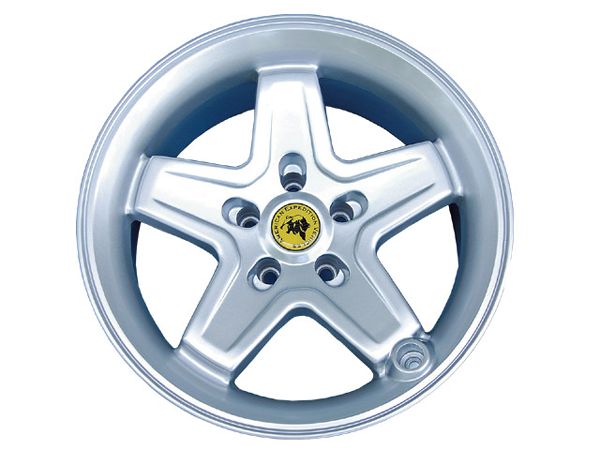
All AEV wheels are available in silver and argent paint with clearcoat. The model shown here is a Pintler, which is available in both a standard wheel and a beadlock. They are designed specifically for Jeep Wranglers, Grand Cherokee, and Commanders, so fitment for these vehicles is exact. In addition to meeting the SAE J2530 standard, AEV wheels have been subjected to the Jeep OE durability tests.
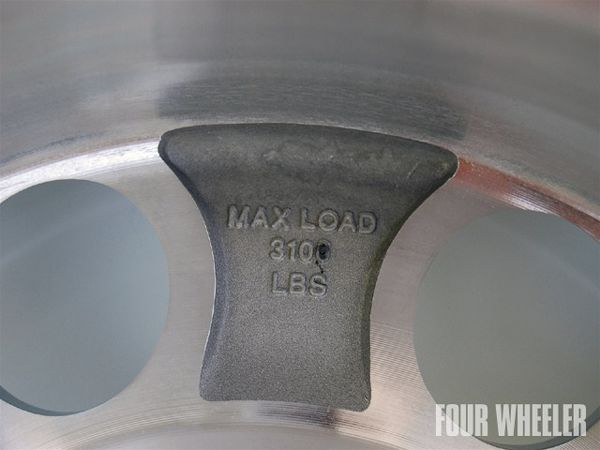
Load Ratings
There is one black-and-white part of wheel selection that you should not overlook - the load rating. Every wheel should have a load rating, and you need to make sure that it's appropriate for your application. If you drive a Samurai, this really isn't too much of a concern, but if you have a 1-ton turbodiesel truck and you use it to haul stuff, pay attention. Load ratings typically start at 2,000 pounds (per wheel) and go up. That's 8,000 pounds of rated load-carrying capability with four wheels, which will work fine for your Jeep Wrangler with a GVWR of 4,500 pounds. For your Ford F-350 with a GVWR of 10,000, however, you'll want a wheel with a minimum of 2,550 pounds. You'll find that most eight-lug wheels have a load rating of over 3,000 pounds. Often times applications for 1/2-ton trucks create problems because a 5- or 6-lug wheel can be found with a lower weight rating, and people are known to haul some pretty heavy loads with 1/2-ton trucks. The Mickey Thompson Classic II wheel shown here is one of the strongest designs in wheels, and carries a 3,100-pound rating on this 5-lug application. It's your responsibility to check this and make sure you're getting the right wheel for your application.
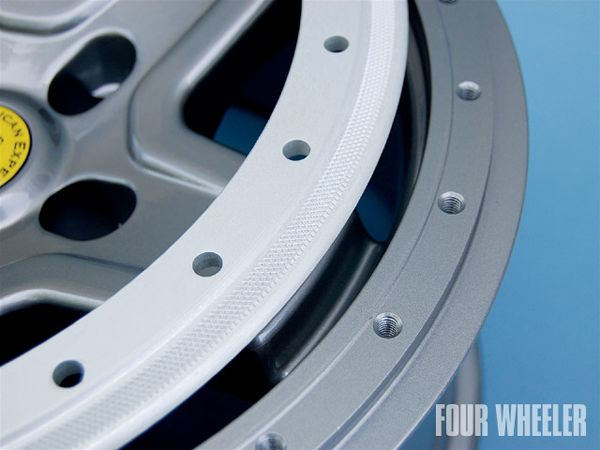
Beadlock, Or Not To Beadlock?
What in the world is a beadlock, and how does it work? When a tire is aired down for off-road use, it's possible to get so much traction that the wheel spins inside the tire. This doesn't help you drive over the obstacle, and it completely messes up the wheel-and-tire balance if you had them balanced. The other thing that can happen with an aired-down tire is that the tire can unseat from the bead. Then you get to try to put the tire back on the bead (hope you have an air compressor on board) or change the tire on the trail. A bit of a delay either way.
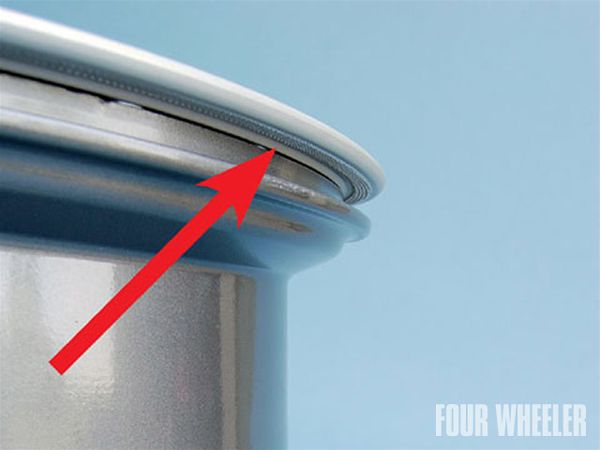
A beadlock wheel is a multi-piece design that clamps the outer bead of the tire in place. In the lower photo, the tire bead would be captured in the space shown by the arrow. The tire can't spin on the wheel, and the outer bead is clamped in place so it cannot unseat. The wheels take a while to assemble, as the bolts need to be tightened incrementally in a criss-cross pattern. The bonus is that you can mount your tires yourself.
The only real beadlock in this article is the AEV Pintler beadlock (shown). The AEV beadlock wheels are cast as beadlocks (not cut and welded, like many beadlock wheels), and are designed to meet all applicable DOT requirements. They also feature a knurled surface on the back of the ring to provide added grip on the tire bead.
Beadlock wheels have a reputation for leaking air. We think this might be from very early versions. We have a vehicle that has been on beadlock wheels for eight years now without any more air loss than we experience with any other wheels.








